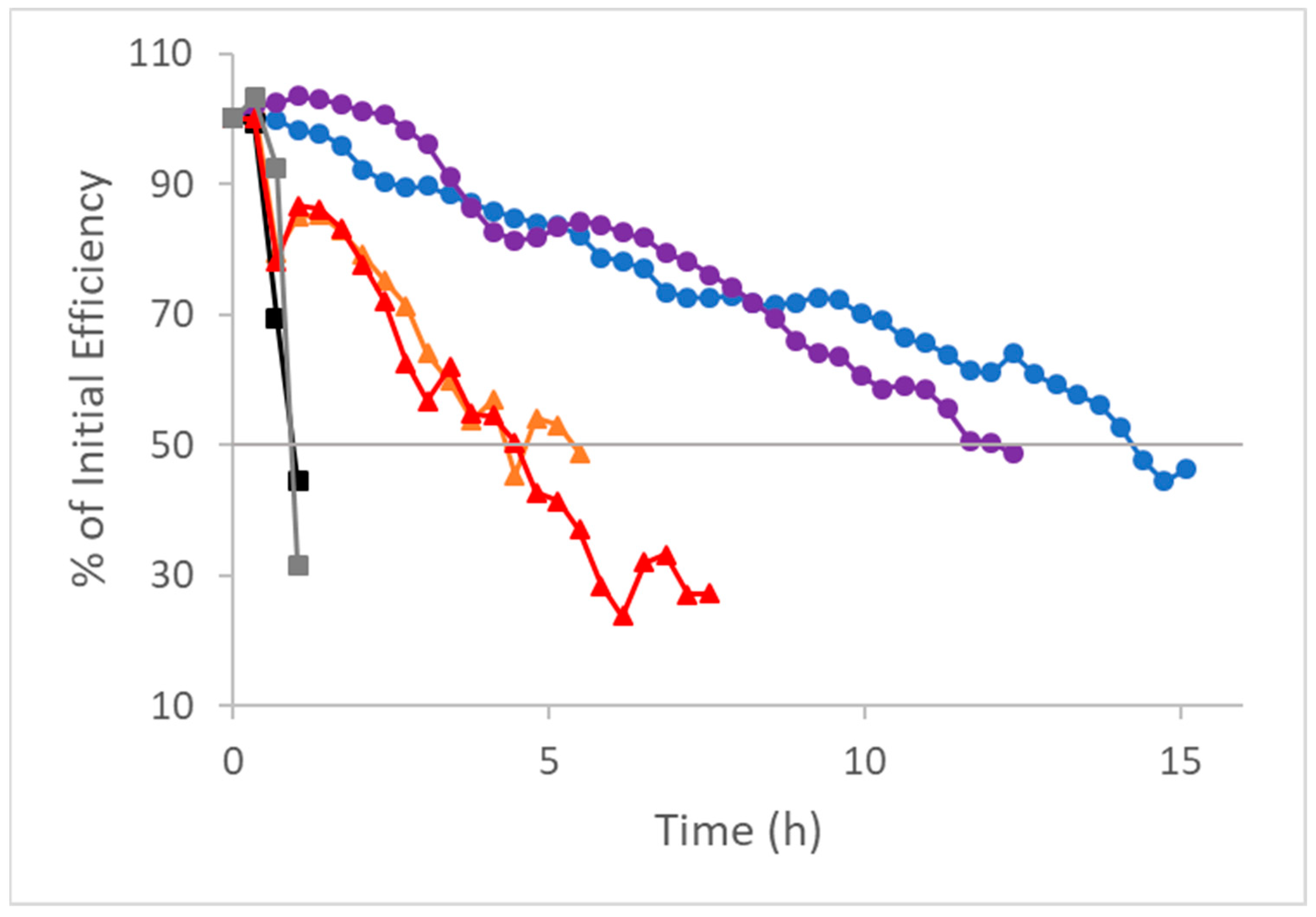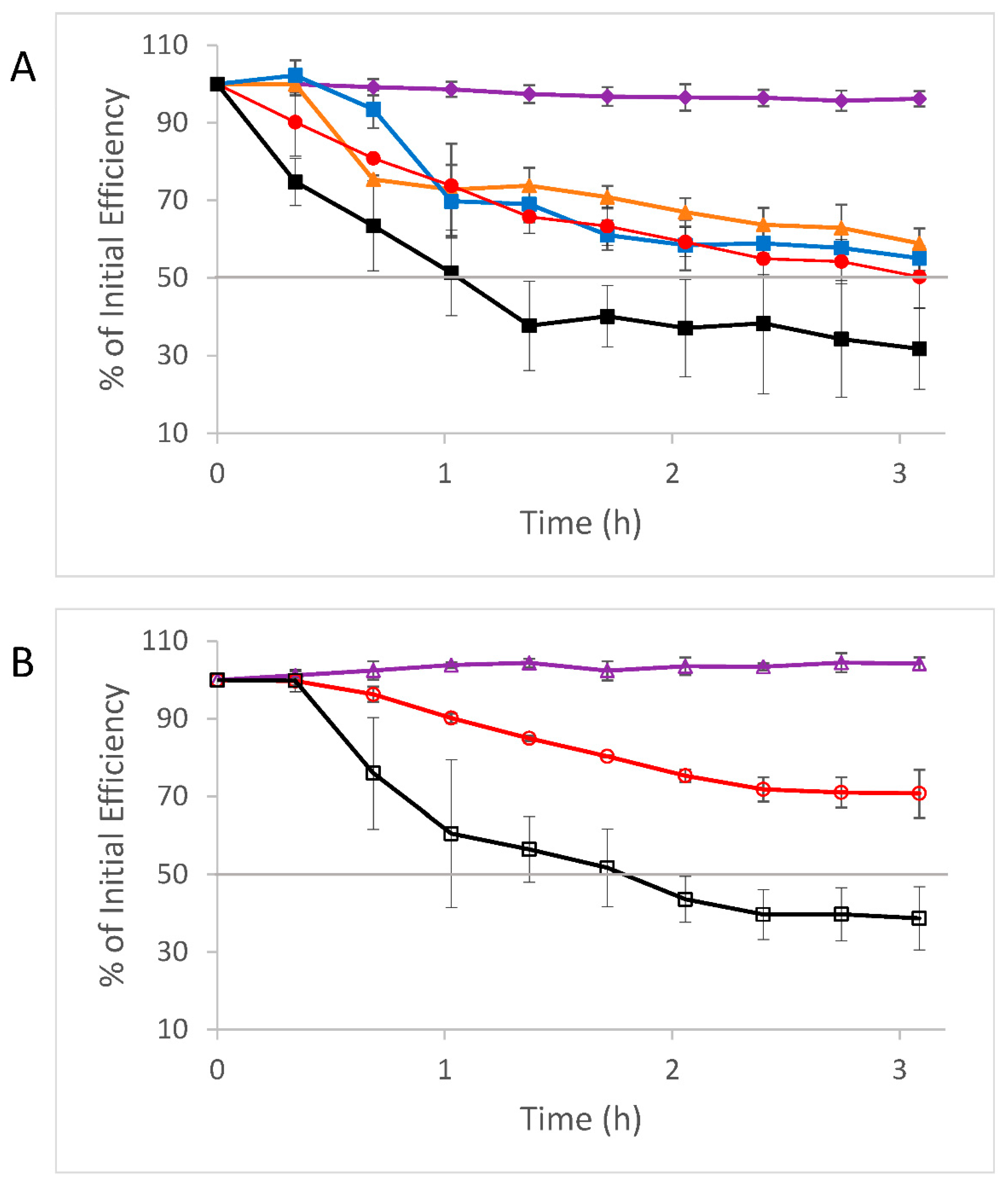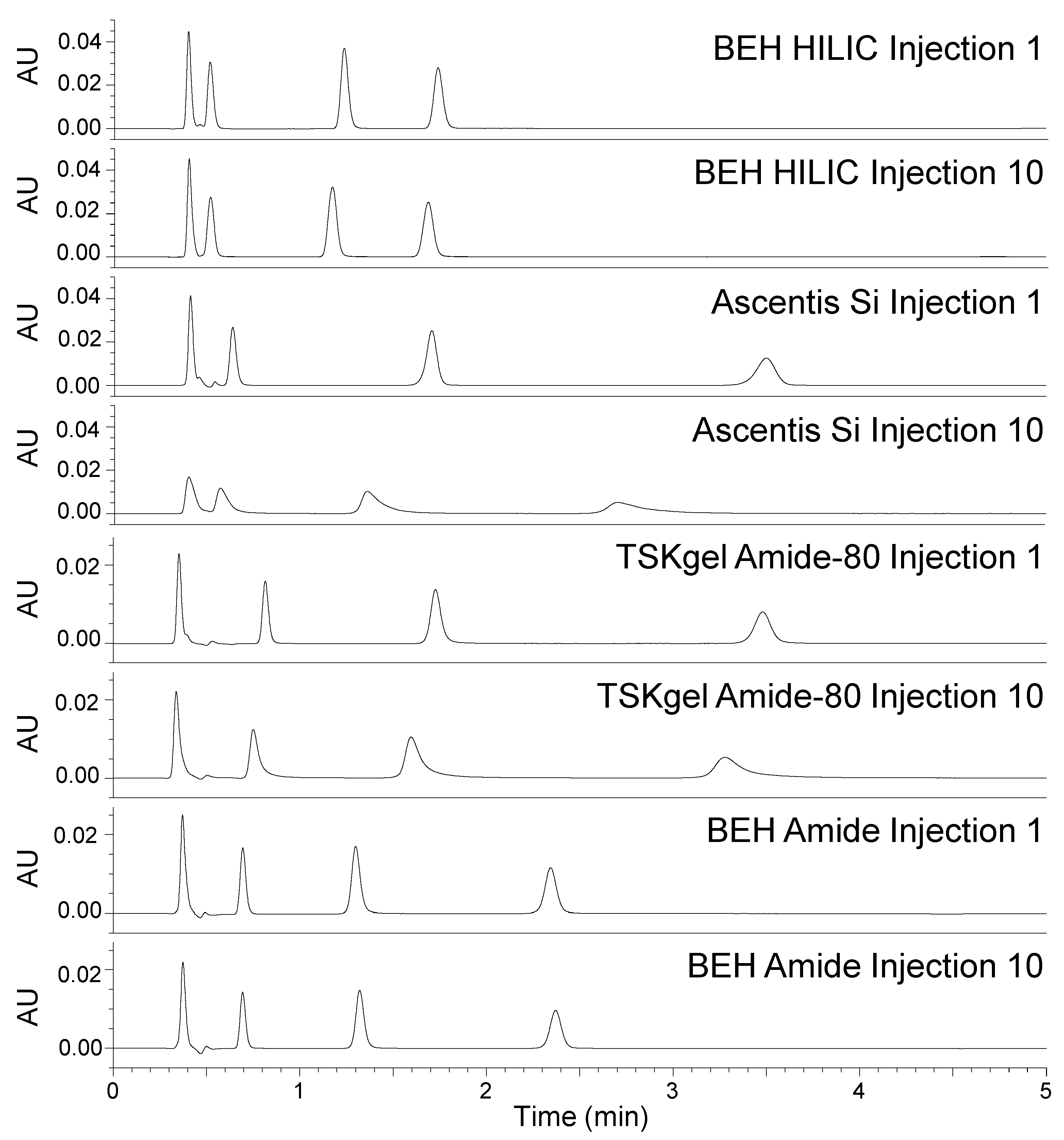Evaluation of the Base Stability of Hydrophilic Interaction Chromatography Columns Packed with Silica or Ethylene-Bridged Hybrid Particles
Abstract
:1. Introduction
2. Materials and Methods
2.1. Chemicals
2.2. Instrumentation and Columns
2.3. Sample and Mobile Phase Preparation
2.4. Method Details
3. Results
3.1. pH Values in Mixed Organic-Aqueous vs. Aqueous solutions
3.2. Stability of CORTECS HILIC Columns as a Function of Water Content
3.3. Stability of CORTECS HILIC Columns as a Function of pH
3.4. Stability of CORTECS HILIC Columns as a Function of Temperature
3.5. Stability Comparison of Silica and Ethylene-Bridged Hybrid Columns
4. Discussion
5. Conclusions
Supplementary Materials
Author Contributions
Funding
Informed Consent Statement
Data Availability Statement
Conflicts of Interest
References
- Alpert, A.J. Hydrophilic interaction chromatography for the separation of peptides, nucleic acids and other polar compounds. J. Chromatogr. 1990, 499, 177–196. [Google Scholar] [CrossRef]
- Hemström, P.; Irgum, K. Hydrophilic interaction chromatography. J. Sep. Sci. 2006, 29, 1784–1821. [Google Scholar] [CrossRef]
- Jandera, P. Stationary and mobile phases in hydrophilic interaction chromatography: A review. Anal. Chim. Acta 2011, 692, 1–25. [Google Scholar] [CrossRef]
- Guo, Y.; Gaiki, S. Retention and selectivity of stationary phases for hydrophilic interaction chromatography. J. Chromatogr. A 2011, 1218, 5920–5938. [Google Scholar] [CrossRef]
- Wahab, M.F.; Ibrahim, M.E.A.; Lucy, C.A. Carboxylate modified porous graphitic carbon: A new class of hydrophilic interaction liquid chromatography phases. Anal. Chem. 2013, 85, 5684–5691. [Google Scholar] [CrossRef]
- Ibrahim, M.E.A.; Wahab, M.F.; Lucy, C.A. Hybrid carbon nanoparticles modified core-shell silica: A high efficiency carbon-based phase for hydrophilic interaction chromatography. Anal. Chim. Acta 2014, 820, 187–194. [Google Scholar] [CrossRef]
- Hou, Y.; Zhang, F.; Liang, X.; Yang, B.; Liu, X.; Dasgupta, P.K. Poly(vinyl alcohol) modified porous graphitic carbon stationary phase for hydrophilic interaction liquid chromatography. Anal. Chem. 2016, 88, 4676–4681. [Google Scholar] [CrossRef]
- Wimalasinghe, R.M.; Weatherly, C.A.; Wahab, M.F.; Thakur, N.; Armstrong, D.W. Geopolymers as a new class of high pH stable supports with different chromatographic selectivity. Anal. Chem. 2018, 90, 8139–8146. [Google Scholar] [CrossRef]
- Kartsova, L.A.; Bessonova, E.A.; Somova, V.D. Hydrophilic interaction chromatography. J. Anal. Chem. 2019, 74, 415–424. [Google Scholar] [CrossRef]
- Iler, R.K. The Chemistry of Silica; Wiley: New York, NY, USA, 1979; pp. 3–104. [Google Scholar]
- Law, B.; Chan, P.F. Stability of silica packing materials towards a mixed aqueous-organic eluent at alkaline pH. J. Chromatogr. 1989, 467, 267–271. [Google Scholar] [CrossRef]
- Huang, Z.; Richards, M.A.; Zha, Y.; Francis, R.; Lozano, R.; Ruan, J. Determination of inorganic pharmaceutical counterions using hydrophilic interaction chromatography coupled with a Corona CAD detector. J. Pharm. Biomed. Anal. 2009, 50, 809–814. [Google Scholar] [CrossRef]
- Qian, K.; Peng, Y.; Zhang, F.; Yang, B.; Liang, X. Preparation of a low bleeding polar stationary phase for hydrophilic interaction liquid chromatography. Talanta 2018, 182, 500–504. [Google Scholar] [CrossRef]
- Qian, K.; Yang, Z.; Zhang, F.; Yang, B.; Dasgupta, P.K. Low-bleed silica-based stationary phase for hydrophilic interaction chromatography. Anal. Chem. 2018, 90, 8750–8755. [Google Scholar] [CrossRef]
- Walter, T.H.; Blaze, M.T.; Boissel, C. Electrospray ionization mass spectrometry ion suppression/enhancement caused by column bleed for three mixed-mode reversed-phase/anion-exchange high performance liquid chromatography columns. Rapid Commun. Mass Spectrom. 2021, 35, e9098. [Google Scholar] [CrossRef]
- Wang, Y.; Wahab, M.F.; Breitbach, Z.S.; Armstrong, D.W. Carboxylated cyclofructan 6 as a hydrolytically stable high efficiency stationary phase for hydrophilic interaction liquid chromatography and mixed mode separations. Anal. Methods 2016, 8, 6038–6045. [Google Scholar] [CrossRef]
- Li, C.; Hao, W.; Yan, F.; Su, M. Aminopropyl-functionalized ethane-bridged periodic mesoporous organosilica spheres: Preparation and application in liquid chromatography. J. Chromatogr. A 2011, 1218, 408–415. [Google Scholar] [CrossRef]
- Fountain, K.J.; Xu, J.; Diehl, D.M.; Morrison, D. Influence of stationary phase chemistry and mobile-phase composition on retention, selectivity, and MS response in hydrophilic interaction chromatography. J. Sep. Sci. 2010, 33, 740–751. [Google Scholar] [CrossRef]
- Teleki, A.; Sánchez-Kopper, A.; Takors, R. Alkaline conditions in hydrophilic interaction chromatography for intracellular metabolite quantification using tandem mass spectrometry. Anal. Biochem. 2015, 475, 4–13. [Google Scholar] [CrossRef]
- Zhang, T.; Creek, D.J.; Barrett, M.P.; Blackburn, G.; Watson, D.G. Evaluation of coupling reversed phase, aqueous normal phase, and hydrophilic interaction liquid chromatography with orbitrap mass spectrometry for metabolomic studies of human urine. Anal. Chem. 2012, 84, 1994–2001. [Google Scholar] [CrossRef] [Green Version]
- Zhang, R.; Watson, D.G.; Wang, L.; Westrop, G.D.; Coombs, G.H.; Zhang, T. Evaluation of mobile phase characteristics on three zwitterionic columns in hydrophilic interaction liquid chromatography mode for liquid chromatography-high resolution mass spectrometry based untargeted metabolite profiling of Leishmania parasites. J. Chromatogr. A 2014, 1362, 168–179. [Google Scholar] [CrossRef] [Green Version]
- Petrova, B.; Warren, A.; Vital, N.Y.; Culhane, A.J.; Maynard, A.G.; Wong, A.; Kanarek, N. Redox metabolism measurement in mammalian cells and tissues by LC-MS. Metabolites 2021, 11, 313. [Google Scholar] [CrossRef]
- Grumbach, E.S.; Diehl, D.M.; Neue, U.D. The application of novel 1.7 μm ethylene bridged hybrid particles for hydrophilic interaction chromatography. J. Sep. Sci. 2008, 31, 1511–1518. [Google Scholar] [CrossRef]
- Wehrli, A.; Hildenbrand, J.C.; Keller, H.P.; Stampfli, R.; Frei, R.W. Influence of organic bases on the stability and separation properties of reversed-phase chemically bonded silica gels. J. Chromatogr. 1978, 149, 199–210. [Google Scholar] [CrossRef]
- Kirkland, J.J.; van Straten, M.A.; Claessens, H.A. High pH mobile phase effects on silica-based reversed-phase high-performance liquid chromatographic columns. J. Chromatogr. A 1995, 691, 3–19. [Google Scholar] [CrossRef] [Green Version]
- Claessens, H.A.; van Straten, M.A.; Kirkland, J.J. Effects of buffers on silica-based column stability in reversed-phase high-performance liquid chromatography. J. Chromatogr. A 1996, 728, 259–270. [Google Scholar] [CrossRef]
- Tindall, G.W.; Perry, R.L. Explanation for the enhanced dissolution of silica column packing in high pH phosphate and carbonate buffers. J. Chromatogr. A 2003, 988, 309–312. [Google Scholar] [CrossRef]
- Canals, I.; Portal, J.A.; Bosch, E.; Rosés, M. Retention of ionizable compounds on HPLC. 4. mobile phase pH measurement in methanol/water. Anal. Chem. 2000, 72, 1802–1809. [Google Scholar] [CrossRef]
- Espinosa, S.; Bosch, E.; Rosés, M. Retention of ionizable compounds on HPLC. 5. pH scales and the retention of acids and bases with acetonitrile-water mobile phases. Anal. Chem. 2000, 72, 5193–5200. [Google Scholar] [CrossRef]
- Espinosa, S.; Bosch, E.; Rosés, M. Retention of ionizable compounds on HPLC. 12. The properties of liquid chromatography buffers in acetonitrile-water mobile phases that influence HPLC retention. Anal. Chem. 2002, 74, 3809–3818. [Google Scholar] [CrossRef]
- Subirats, X.; Bosch, E.; Rosés, M. Retention of ionizable compounds on high-performance liquid chromatography XV. Estimation of the pH variation of aqueous buffers with the change of the acetonitrile fraction of the mobile phase. J. Chromatogr. A 2004, 1059, 33–42. [Google Scholar] [CrossRef]
- Rosés, M. Determination of the pH of binary mobile phases for reversed-phase liquid chromatography. J. Chromatogr. A 2004, 1037, 283–298. [Google Scholar] [CrossRef]
- Subirats, X.; Bosch, E.; Rosés, M. Retention of ionizable compounds on high-performance liquid chromatography XVIII: pH variation in mobile phases containing formic acid, piperazine, tris, boric acid or carbonate as buffering systems and acetonitrile as organic modifier. J. Chromatogr. A 2009, 1216, 2491–2498. [Google Scholar] [CrossRef]
- Alvarez-Segura, T.; Subirats, X.; Rosés, M. Retention-pH profiles of acids and bases in hydrophilic interaction liquid chromatography. Anal. Chim. Acta 2019, 1050, 176–184. [Google Scholar] [CrossRef]
- Wyndham, K.D.; O’Gara, J.E.; Walter, T.H.; Glose, K.H.; Lawrence, N.L.; Alden, B.A.; Izzo, G.S.; Hudalla, C.J.; Iraneta, P.C. Characterization and evaluation of C18 HPLC stationary phases based on ethyl-bridged hybrid organic/inorganic particles. Anal. Chem. 2003, 75, 6781–6788. [Google Scholar] [CrossRef]
- Walter, T.H.; Alden, B.A.; Berthelette, K.; Field, J.A.; Lawrence, N.L.; McLaughlin, J.; Patel, A.V. Characterization of a highly stable zwitterionic hydrophilic interaction chromatography stationary phase based on hybrid organic-inorganic particles. J. Sep. Sci. 2022, 45, 1389–1399. [Google Scholar] [CrossRef]
- Davis, P.J.; Deshpande, R.; Smith, D.M.; Brinker, C.J.; Assink, R.A. Pore structure evolution in silica gel during aging/drying. IV. Varying pore fluid pH. J. Non-Cryst. Solids 1994, 167, 295–306. [Google Scholar] [CrossRef]
- Kirkland, J.J.; Henderson, J.W.; DeStefano, J.J.; van Straten, M.A.; Claessens, H.A. Stability of silica-based, endcapped columns with pH 7 and 11 mobile phases for reversed-phase high-performance liquid chromatography. J. Chromatogr. A 1997, 762, 97–112. [Google Scholar] [CrossRef] [Green Version]





| Time (min) | Flow Rate (mL/min) | %A—Water | %B— Acetonitrile | %C—100 mM Ammonium Formate pH 3 (aq) | %D—Challenge Solution | Curve 1 |
|---|---|---|---|---|---|---|
| initial | 0.400 | 0.0 | 95.0 | 5.0 | 0.0 | initial |
| 13.73 | 0.400 | 0.0 | 0.0 | 0.0 | 100.0 | 11 |
| 34.30 | 0.400 | 0.0 | 0.0 | 0.0 | 100.0 | 11 |
| 35.97 | 0.400 | 50.0 | 50.0 | 0.0 | 0.0 | 6 |
| 39.27 | 0.400 | 50.0 | 50.0 | 0.0 | 0.0 | 6 |
| 40.93 | 0.400 | 10.0 | 90.0 | 0.0 | 0.0 | 6 |
| 44.23 | 0.400 | 10.0 | 90.0 | 0.0 | 0.0 | 6 |
| 45.90 | 0.400 | 0.0 | 95.0 | 5.0 | 0.0 | 6 |
| 68.13 | 0.400 | 0.0 | 95.0 | 5.0 | 0.0 | 11 |
| pH | |||
|---|---|---|---|
| % ACN | Ammonium Acetate | Ammonium Bicarbonate | Ammonium Bicarbonate |
| 0 | 5.60 | 7.80 | 11.00 |
| 10 | 5.83 | 8.34 | 10.68 |
| 20 | 6.04 | 8.49 | 10.64 |
| 30 | 6.27 | 8.74 | 10.60 |
| 40 | 6.52 | 8.81 | 10.54 |
| 50 | 6.76 | 8.80 | 10.44 |
| 60 | 6.99 | 8.96 | 10.37 |
| 70 | 7.25 | 9.12 | 10.25 |
| 80 | 7.55 | 9.40 | 10.11 |
| 90 | 7.79 | 9.75 | 10.28 |
| Stationary Phase | Particle Chemistry | Surface Chemistry | Morphology | Particle Size (μm) | Average Pore Diameter (Å) | Surface Area (m2/g) | Recommended pH Range |
|---|---|---|---|---|---|---|---|
| Accucore HILIC | silica | unbonded | solid-core | 2.6 | 80 | 130 | 2–8 |
| Ascentis Si | silica | unbonded | fully porous | 3.0 | 100 | 450 | 2–6 |
| Atlantis HILIC | silica | unbonded | fully porous | 3.0 | 100 | 330 | 1–5 |
| BEH Amide | BEH | amide | fully porous | 1.7 | 130 | 185 | 2–11 |
| BEH HILIC | BEH | unbonded | fully porous | 1.7 | 130 | 185 | 1–9 |
| CORTECS HILIC | silica | unbonded | solid-core | 1.6 | 90 | 100 | 1–5 |
| SeQuant ZIC-HILIC | silica | sulfobetaine | fully porous | 3.5 | 100 | 180 | 3–8 |
| TSKgel Amide-80 | silica | amide | fully porous | 2.0 | 80 | 450 | 2.0–7.5 |
| Thymine | Adenine | Cytosine | Overall | ||||
|---|---|---|---|---|---|---|---|
| Stationary Phase | Avg | St Dev | Avg | St Dev | Avg | St Dev | Avg |
| Ascentis Si | −22.5 | 1.3 | −24.4 | 2.9 | −23.8 | 2.3 | −23.6 |
| Atlantis HILIC | −9.1 | 0.4 | −9.5 | 0.9 | −8.7 | 0.7 | −9.1 |
| Accucore HILIC | −6.0 | 2.8 | −8.1 | 1.5 | −4.4 | 2.1 | −6.2 |
| BEH HILIC | −1.1 | 0.7 | −8.6 | 0.1 | −4.8 | 0.2 | −4.8 |
| TSKgel Amide-80 | −5.7 | 1.7 | −4.1 | 1.2 | −1.5 | 1.3 | −3.8 |
| SeQuant ZIC-HILIC | −1.5 | 0.7 | −4.4 | 0.6 | −3.1 | 0.7 | −3.0 |
| CORTECS HILIC | −1.1 | 2.4 | −6.4 | 1.8 | 0.8 | 2.9 | −2.2 |
| BEH Amide | −1.3 | 0.3 | 1.6 | 1.3 | 1.0 | 1.1 | 0.4 |
Publisher’s Note: MDPI stays neutral with regard to jurisdictional claims in published maps and institutional affiliations. |
© 2022 by the authors. Licensee MDPI, Basel, Switzerland. This article is an open access article distributed under the terms and conditions of the Creative Commons Attribution (CC BY) license (https://creativecommons.org/licenses/by/4.0/).
Share and Cite
Walter, T.H.; Alden, B.A.; Berthelette, K. Evaluation of the Base Stability of Hydrophilic Interaction Chromatography Columns Packed with Silica or Ethylene-Bridged Hybrid Particles. Separations 2022, 9, 146. https://doi.org/10.3390/separations9060146
Walter TH, Alden BA, Berthelette K. Evaluation of the Base Stability of Hydrophilic Interaction Chromatography Columns Packed with Silica or Ethylene-Bridged Hybrid Particles. Separations. 2022; 9(6):146. https://doi.org/10.3390/separations9060146
Chicago/Turabian StyleWalter, Thomas H., Bonnie A. Alden, and Kenneth Berthelette. 2022. "Evaluation of the Base Stability of Hydrophilic Interaction Chromatography Columns Packed with Silica or Ethylene-Bridged Hybrid Particles" Separations 9, no. 6: 146. https://doi.org/10.3390/separations9060146
APA StyleWalter, T. H., Alden, B. A., & Berthelette, K. (2022). Evaluation of the Base Stability of Hydrophilic Interaction Chromatography Columns Packed with Silica or Ethylene-Bridged Hybrid Particles. Separations, 9(6), 146. https://doi.org/10.3390/separations9060146






